Chinese Name: 桃坪羌寨 Pronunciation: táo píng qiāng zhài
Building Time: 111 BC
Recommended Time for Visit: 2-3 Hours
Building Function: To defend against enemies
Address: G317, Taoping Village, Li County, Ngawa Tibetan and Qiang Autonomous Prefecture, Sichuan Province
Occupied Area: 120 mu (80,000 square meters) for the new Taoping Qiang Minority Village
Popular Activities: To celebrate festivals such as “Worshipping the Mountain Festival” (祭山会) and “Qiang Annual Gathering”; songs and dances of the Qiang minority
| Visitors | Price |
| Adults(Aged 19-59) | 60 yuan |
| Children (Aged 6-18 or above 1.2 meters) | 30 yuan |
| Seniors (Aged 60-70) | 30 yuan |
1. Free for seniors older than 70 (including 70).
2. Free for children younger than 6 years(including 6 years) or under 1.2 meters(including 1.2 meters).
| Village Gate | Peak Season (April 1st to October 31st) |
Low Season (November 1st to March 31st) |
| Opening Hours | 8:00-18:00 | 8:30-17:30 |
Located in the northwest of Chengdu, Taoping Qiang Minority Village is 40 kilometers away from Li County, 16 kilometers away from Wenchuan County, and 139 kilometers away from downtown Chengdu. With the underground water network hailed as a natural air-conditioning, intricate passages extending in all directions, and the labyrinth of architecture, the village is well-known as a “live fossil” of the art architecture of the Qiang minority people and is considered a mysterious ancient castle in the east.

Taoping Qiang Minority Village includes two parts, the new and the old villages. The new one not only provides services for tourists but also introduces and carries forward the culture of the ancient Qiang minority, while the old village is mainly for showing the characteristics of local life and architecture.
The new village was built for conducting business activities to better protect the old one in 2008. The occupied area of the new village is 80,000 square meters, and the building area is 45,000 square meters, including the Cultural Performance Center of the Ancient Qiang Minority, History Museum of the Ancient Qiang Minority, and the site for teaching and studying the ancient Qiang culture.
The most interesting spot of the old Taoping Minority Village is the tall watchtowers. They were built for delivering messages and defending against enemies. Up to now, the watchtowers remain solid and are mostly in good condition despite after three strong earthquakes.
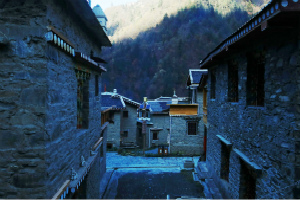
Besides, the intricate alleys in the village are also worth visiting. Different from the traditional cities which may have four entrances in the four directions, Taoping Qiang Minority Village was built with eight entrances in a radial pattern, which makes it so unique. The eight entrances and thirteen alleys are connected, forming a weaving network like a maze. In ancient times, this design helped the local people to defend against enemies more easily. But today, it often gets people lost.
The local residences are called Zhuang Fang. Its overall structure is square. The houses usually have three stories: the lowest one is used to raise livestock and store farm tools, the second story for living, and the top for storing grains and sundries. This architecture artfully demonstrates the philosophy of the ancient Qiang people – people are above the livestock while god is above people.
There are upright columns inside to support the house. The windows are small inside but big outside to keep warm and make shooting easier when defending against intruders.
What’s more, due to the beautiful natural landscape, the first TV drama with the theme of ecological protection, Sacred Hoh Xil, was filmed at Taoping Qiang Minority Village.
Taoping Qiang Minority Village was originally built in 111 BC during the reign of Emperor Wudi in the Western Han Dynasty (206 BC – 24 AD). At that time, the village was built as an important mountain pass and fortress to deliver messages and defend enemies. The original name of Taoping Minority Village was Red Creek Village(chixi in Chinese). It is said that the village was named after a creek with numerous red stones. Up to now, Taoping Qiang Minority Village is the best-preserved architecture of the Qiang minority in the world.
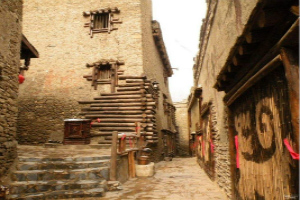
In 2007, Taoping Qiang Minority Village was designated as an important national cultural heritage site.
In 2008, Taoping Qiang Minority Village was hit by a powerful earthquake. The houses and watchtowers in the village were partly destroyed. To protect the precious culture and architecture of the Qiang minority, the State Cultural Relics Bureau invested a total of 0.08 billion yuan for repairing the destroyed houses and buildings, covering the ancient watchtowers, underground water networks, the village gate, secret passages, and so on. The new village was also built at that time.
Also, in 2008, Taoping Qiang Minority Village was placed in the application candidate list of the UNESCO’s World Cultural Heritage.
In 2011, Taoping Qiang Minority Village was honored with the titles of “Beautiful Landscape Village in China” and one of “The Ten Most Beautiful Villages in Sichuan Province”.
In 2012, it became an AAAA National Tourist Attraction.
The watchtowers at Taoping Qiang Minority Village have enjoyed a high reputation for their long history, distinctive structure, solidarity, and the intelligence of the builders. The watchtowers, also called “Qiong Long” in ancient times, have been established for more than 2000 years. The number of existing watchtowers is only two. One is a personal residence. The other one stands on the riverbank opposite the village.
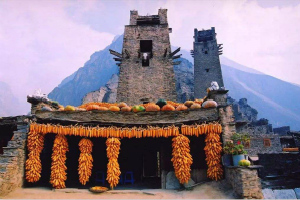
The current largest watchtower is about 30 meters high with nine stories. And at the four directions of each story, there are four openings for shooting during the war, and the hole on the top is used for delivering messages.
The bottom of the houses is deeper than usual buildings. The ancient Qiang people dug two meters to set the base stone, which enhanced its solidarity.
The houses were made from bonded slice-shaped stone and yellow soil. The builders did not use the drawings nor lifting string for determining the upright direction. What they depended on are their rich experience and skilled techniques.
Surprisingly, this kind of architecture in the village was so solid that it was just slightly destroyed and there were no casualties in the three strong earthquakes measuring above 7.0 magnitude. According to experts, this is because the distinctive structure disperses the pressure, and the connected architecture also supports each other.
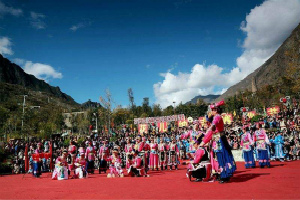
The song and dance of the Qiang minority is another characteristic of Taoping Qiang Minority Village. The Qiang people are good at singing and dancing with a history of over 2000 years. It is an important activity to express their emotions or show their lives, such as expressing love and worship. Therefore, it would be a pity to miss their singing and dancing activities.
When it is on the New Year or a wedding ceremony, the Qiang people will get together, light a bonfire, drink highland barley wine, sing folk songs, and dance Shalangwu (a kind of local dance). Sometimes they will play all night long. Traveling in Taoping Qiang Minority Village, you can enjoy the songs and dances of the Qiang minority, or you can participate in the bonfire party. After you enjoy the delicious local food, dancing with the local people will be a great pleasure.
The well-organized and excellent underground water network is a unique and great design in the world. The ancient Qiang people dug lots of canals and built wide underground drains with stone plates. The water comes from the snow mountain with a height of over 5,000 meters, and the spring water flows into every house through the drains. At the same time, the local people can also directly draw water from the drains by moving the movable stone plates.
During war times, the underground water network could also prevent enemies to cut off their water supply and serve as a tunnel escape. Besides, it can adjust the temperature in different seasons, purify the air, and prevent fire in peacetime. It is a genuine “green air-conditioning”.
After a strong earthquake in 2008, experts checked the water quality. The results showed that the spring water was clean and suitable for drinking as usual.
In the age of humans and gods living together, there was no fire on the earth. The humans were cold in the winter and had no access to a hot meal or cooked food. Their lives were hard.
A man named Ranbiwa from the Qiang minority wanted to change this situation. He was eager to give his people a better life, so he decided to steal the fire from the gods. He managed to overcome all difficulties and dangers on the road, and fortunately, he succeeded. Since then, the fire has been burning for tens of thousands of years at Taoping Village.
It is said that over 200 years ago, ancient people with the last names of Tao and Zhu were living in Taoping Qiang Minority Village. They planted numerous peach trees in the village, so there were blooming flowers in spring and countless fruits in summer. To commemorate their ancestors, the later generations changed the village name to Taoshuping (“Tao” means “peach” in Chinese), also called Taoziping, which was called Taoping for short. That is why people call it Taoping Village now.
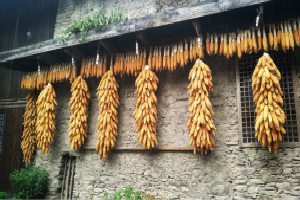
According to the records of the Qiang minority, the ancient Qiang people have migrated many times to find better places to live. During the process of migration, some of them encountered the Geji minority at the Minjiang River in Sichuan Province. They battled for the places suitable to live. The war was ended with the failure of the Qiang people, and they had to leave and look for another place.
However, one night, the Sky God taught the Qiang people in the dream how to make new weapons with white stones and wooden sticks. The Qiang people won the war with the new weapons. Since then, the Qiang people have worshiped the Sky God as their supreme god. When they built their houses and watchtowers, a white stone would be placed on the roof to show their respect.
Enter from the New Taoping Qiang Minority Village → the Old Taoping Qiang Minority Village → Watchtower → Folk Residences → Return to the New Taoping Qiang Minority Village
If you go to Taoping Minority Village from Chadianzi Passenger Station at Chengdu, please take the long-distance bus from Chadianzi Station to Li County Tourism Passenger Center and take off at Taoping Village. It takes about 4 hours (about 70 yuan).
Chinese: 请带我去桃坪羌寨。English: Please take me to Taoping Qiang Minority Village.
If you go to Taoping Qiang Minority Village from the center of Chengdu (Home Inn Hotel), it takes about 4 hours (about 450 yuan).
If you go to Taoping Qiang Minority Village from Chengdu Railway Station, it takes about 4 hours (about 450 yuan).
If you go to Taoping Qiang Minority Village from Chengdu East Railway Station, it takes about 4 hours (about 450 yuan).
If you go to Taoping Qiang Minority Village from Chengdu Shuangliu International Airport, it takes about 4 hours (about 450 yuan).
